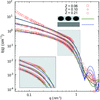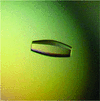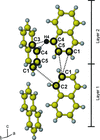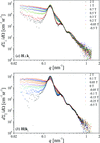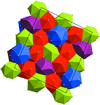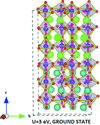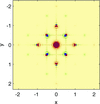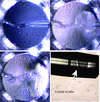issue contents
June 2014 issue

Cover illustration: Characterization of the catalytic coating on a metallic foam by means of X-ray powder diffraction tomography. Courtesy of De Nolf et al. [J. Appl. Cryst. (2014), 47, 1107-1117].
research papers
Thermal expansion and decomposition of nitrogen-expanded austenite has been studied with in situ synchrotron X-ray diffraction. A transitional phase with composition M4N (M = Fe, Cr, Ni, Mo) appears for high nitrogen contents and the decomposition products are austenite, ferrite and CrN.
This article describes the development of the scattering form factor for N aligned particles and N aligned particles inside a cylinder and its application to polyelectrolyte–surfactant complexes.
This article describes an evaluation of the accuracy of quantitative phase analysis of stoneware ceramics and bricks.
The aim of the current work is to highlight and explain the effectiveness of the lamella alignment ratio technique as an analysis tool for macromolecular crystal reorganization, crystallographic structural changes and crystal deformation during simultaneous strain measurements.
This article proposes a framework for smoothing of and Kα doublet elimination from X-ray diffraction scans in an automated fashion. Smoothing is performed using penalized likelihood estimation, while for doublet elimination the model is extended using the composite link model.
A new strain-based Fourier method to generate virtual diffraction peaks from defected crystalline media is developed. The mathematically rigorous formulation conforms with both the kinematic theory of diffraction and the theory of crystal defects, and establishes domains of applicability of the existing virtual diffraction peak generation techniques.
Transmission electron microscopy (TEM) analysis indicates the coexistence of three 120° monoclinic twinning variants in the Li1.07Mn1.93O4−δ cathode materials. A theoretical investigation of the influence of stacking disorder on the X-ray diffraction (XRD) patterns was performed by employing the DIFFaX program and may help to clarify the ambiguity between experimental TEM and XRD investigations.
A forward modeling methodology is presented for identifying slip system activity in intermediate- and far-field high-energy diffraction microscopy experiments. Diffraction peaks measured during an in situ compression test on a single-crystal silicon sample at high temperature confirm the accuracy of the proposed peak evolution/slip system activity model.
A new method analyzes solution scattering data from equilibrium mixtures of interacting proteins, in order to determine both the association model and the individual scattering curves of the mixture components.
Single-crystal time-of-flight neutron diffraction event data are mapped into reciprocal space. Integration of peaks in reciprocal space provides intensities that lead to more precise and accurate results than those obtained from detector histogram space.
A system for in-house small-angle X-ray scattering/wide-angle X-ray diffraction/Raman simultaneous measurements has been developed. The usefulness of the system has been demonstrated in a structural study of the ferroelectric phase transition of vinylidene fluoride–trifluoroethylene copolymers described herein.
Pure and Mo-doped potassium titanyl phosphate (KTP) crystals have been grown by the high-temperature solution growth technique. The effect of doping on crystalline perfection in different growth planes has been investigated. The observed structural defects are probably due to mechanical or thermal fluctuations occurring during the growth process.
A new method for determination of the stacking fault energy in face-centred cubic materials is presented, which utilizes in situ X-ray diffraction performed during the early stages of the plastic deformation of the sample. Additionally, this method gives information about the formation, widening and interaction of stacking faults at different applied stresses. The capability of this method is illustrated on highly alloyed austenitic steels with the transformation-induced plasticity effect, in which the plastic deformation is accompanied by martensitic transformation of austenite.
Current data deposited in the Protein Data Bank have been used to guide the design of a modular 96-well crystallization screen (HELIX) that integrates into one format cryofreezing, additives to stabilize specific topologies, formulations for higher molecular weight targets and a customizable orthogonal-based screen. Moreover, contrary to most current commercial nucleic acid crystallization kits, the formulations in HELIX avoid cacodylate-containing buffers, which can mask the scattering of useful intrinsic anomalous scatterers, such as bromine and selenium.
The interplay between local strain development and the austenite-to-martensite transformation in low-alloyed transformation-induced-plasticity (TRIP) steel has been studied in situ during shear deformation by spatially resolved high-energy X-ray diffraction experiments in the vicinity of the shear zone.
For the first time, a high-resolution far-field detector has been used to study the initial and evolving structure of individual metastable austenite grains during uniaxial tensile deformation of a transformation-induced plasticity (TRIP) steel sample. The orientation, position and lattice parameters of the selected grains were reconstructed from additional measurements with a lower-resolution medium-field detector.
Open  access
access
 access
accessAn improved method of calibrating neutron time-of-flight single-crystal instruments is described. The calibration method has led to improved lattice parameter determination and ability of the orientation matrix to describe the reflection positions on the detector surface.
Download citation


Download citation


On the basis of powder diffraction data, a change of the compression mechanism to predominant contraction along the herringbone layer was found in naphthalene at a pressure of >2 GPa, resulting from the pressure-induced strengthening of intermolecular interactions between the layers.
Open  access
access
 access
accessThe results of magnetic field dependent small-angle neutron scattering measurements on a cobalt nanorod array are reported. The data provide evidence for the existence of intraparticle spin disorder.
Download citation


Download citation


The effect of Sn for Ti substitution on the room-temperature crystal structure of a series of perovskite-like barium titanate stannate compounds was investigated. The results of detailed X-ray powder diffraction, high-resolution transmission electron microscopy and selected-area electron diffraction analyses indicate that, on the long-range scale, a gradual increase of the Sn content provokes the transformation of the crystal structure from tetragonal to cubic, while Raman spectroscopy results reveal a lower local ordering than the average symmetry.
Lattice thermal expansion of NpO2 has been measured up to 2000 K by in situ X-ray diffraction. Above 1643 K, the departure from linearity is interpreted on the basis of the calculation of the vacancy formation energy from the oxygen Debye temperature, as a combination of chemical reduction into NpO2−x and the development of oxygen Frenkel pairs.
In 1948, Alexander, Klug and Kummer published a formalism which, for polycrystalline powder specimens, could be used to compute the number of irradiated grains required to obtain diffraction peak intensities within a specified uncertainty range. The current study shows that part of this analysis is not applicable for all particle sizes and could yield erroneous results for grains with diameters below 10 nm.
The crystal structure of the o-Al4(Cr,Fe) complex metallic alloy has been refined by high-angle annular dark-field scanning transmission electron microscopy real-space crystallography.
Download citation


Download citation


The current paper adapts the methodology for structure solution from zonal precession electron diffraction data for intermetallics. Successful structure solution of a novel Mg48Al36Ag16 phase was performed.
CCDC reference: 999093
A high-precision method for tilt calibration of area detectors is presented. The procedure takes into account continuously varying spatial distortions.
Using polarized neutron reflectometry, the magnetic proximity effect in epitaxial bilayer heterostructures comprising ferromagnetic La0.7Sr0.3MnO3 and multiferroic orthorhombic YMnO3 layers has been investigated.
The presence of ordered nanostructures (nearest-neighbour ordering) is reported in self-organized Co nanopillar-like structures separated by Au spacers, attractive for applications in magnetic storage devices. Most interestingly, a strong dependence of the superparamagnetic blocking temperature on the degree of vertical correlation in the stack is found, which indicates a collective behaviour of individual clusters in the nonmagnetic Au matrix.
Efficient methods of calculating small-angle scattering data through Monte Carlo–Debye methods and fast Fourier transforms are described.
An interactive program for multivariate chemometric analysis of profiles from diffraction or spectroscopic measurements is presented. Examples of the program's usage include quantitative phase analysis of powder X-ray diffraction patterns, correlation analysis of X-ray powder diffraction patterns with nuclear magnetic resonance and mass spectrometry measurements, quantitative analysis of X-ray absorption spectroscopy spectra, and qualitative analysis of small-angle X-ray scattering profiles and macromolecular X-ray diffraction patterns.
To date, the concept of quality control has been noticeably absent in crystallization trials. An analysis toolset has been developed to give rigorous metrics for the `goodness' of a crystallization droplet.
XRDUA is a tool that has been developed and employed successfully for the reconstruction of crystalline phase distribution maps from two-dimensional diffraction patterns collected by scanning and tomographic X-ray powder diffraction.
Open  access
access
 access
accessThe emerging technique of serial X-ray diffraction requires new software tools for the efficient analysis of large volumes of data. Event selection early in the analysis pipeline is highly advantageous. The described software for classifying, sorting and analysing events is freely available to the general community.
computer programs
Open  access
access
 access
accessGENFIT is a new computer code featuring an advanced model-fitting capability to analyse small-angle X-ray and neutron scattering data of macromolecular systems. Batches of experimental curves can be simultaneously best fitted using common parameters issued from combinations of models and, if applicable, constrained by physical and/or phenomenological relations.
Open  access
access
 access
accessElectron diffraction of extremely small three-dimensional crystals (MicroED) allows for structure determination from crystals orders of magnitude smaller than those used for X-ray crystallography. The MicroED suite was developed to accomplish the tasks of unit-cell determination, indexing, background subtraction, intensity measurement and merging, resulting in data that can be carried forward to molecular replacement and structure determination.
The computer program Yell for analyzing diffuse scattering via the three-dimensional delta pair distribution function approach is presented. The program allows flexible and efficient modeling of disorder in single crystals.
laboratory notes
Open  access
access
 access
accessA method exploiting off-the-rack television and game controllers for use by crystallographers and their collaborators for enhanced experience of co-located discussions is presented.
X-ray crystallography typically requires the mounting of crystals, which can make the sample difficult to manipulate when it is small and the microscope objective is close to the crystallization plate. The simple expedient of moving the objective lens to the bottom of a clear crystallization plate greatly facilitates the manipulation and harvesting process.
addenda and errata
Free 



 journal menu
journal menu










